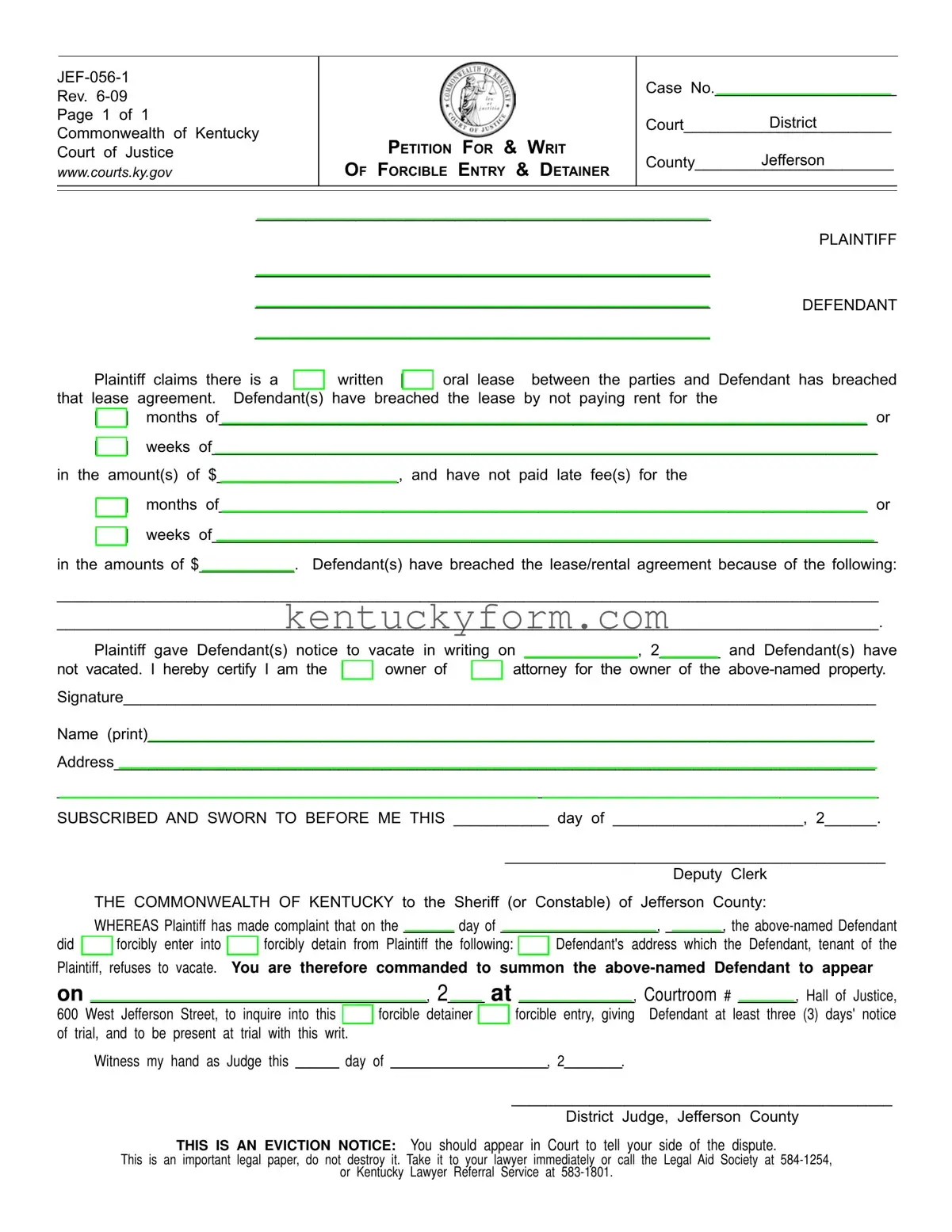What is the JEF 056 1 form used for in the Commonwealth of Kentucky?
The JEF 056 1 form is a legal document used within the Commonwealth of Kentucky's Court of Justice to initiate a process formally called "Forcible Entry & Detainer." This process is commonly used by property owners to evict tenants who have allegedly breached their lease agreements. Such breaches could involve failing to pay rent or not adhering to tenancy rules as stipulated in either a written or oral lease agreement. The document serves as a formal petition to the court to reclaim possession of the property and provides the necessary details to process the eviction legally.
What information must be provided in the JEF 056 1 form?
The form requires detailed information including:
- The names and addresses of both the plaintiff (usually the property owner or their legal representative) and the defendant (the tenant or tenants).
- Specification of whether the lease is written or oral.
- Details of the lease violation, including non-payment of rent (with the specific months or weeks and amounts due) and any other breaches of the lease agreement.
- Date the notice to vacate was given to the tenant.
- Signature and printed name of the plaintiff or the plaintiff’s legal representative, along with their address.
- Details for the court about when and where the court proceedings will occur, including a directive to the Sheriff or Constable to summon the defendant to court.
What are the implications of receiving a JEF 056 1 form for a tenant?
Receiving a JEF 056 1 form signifies a formal eviction process initiated by the landlord. It serves as a legal notice that the tenant must vacate the premises due to alleged violations of the lease agreement, most commonly for failing to pay rent. The form also informs the tenant of their right and the necessity to appear in court on a specified date to present their side of the story. Ignoring this notice may result in a forcible eviction carried out by law enforcement. Therefore, it's crucial for tenants to take this notice seriously and either make immediate efforts to rectify the violations or prepare to defend their case in court.
How does one file a JEF 056 1 form?
The process involves accurately completing the form with all required details and submitting it to the Jefferson County court. The form must include specific information about the breach of lease, the date the eviction notice was served, and other relevant details as outlined above. The plaintiff may need to provide evidence of the lease agreement and documentation of the breach. Upon submission, the court will review the petition and, if found in order, will schedule a hearing. It’s recommended to seek legal assistance when completing this form to ensure accuracy and compliance with Kentucky’s eviction laws.
What happens after the form is filed?
Once the JEF 056 1 form is filed and accepted by the court, the following steps occur:
- The court schedules a hearing date and commands the Sheriff or Constable of Jefferson County to summon the tenant, providing them at least three days’ notice of the trial.
- The landlord and tenant are expected to appear in court on the scheduled date. The landlord must prove the tenant’s violation of the lease, while the tenant has the opportunity to present their defense.
- If the court rules in favor of the landlord, a writ of eviction will be issued, authorizing law enforcement to remove the tenant from the property.
- If the tenant wins, they may continue to occupy the property, assuming they rectify any confirmed breaches as directed by the court.
Can a tenant contest an eviction initiated through a JEF 056 1 form?
Yes, a tenant has the right to contest an eviction. The legal process allows tenants to defend themselves against an eviction notice in court. They may argue that the eviction is unjustified, prove that the lease was not breached as claimed by the landlord, or demonstrate efforts to remedy any breaches before the court date. Legal representation or advice is highly recommended for tenants in such situations to ensure a fair hearing and understanding of their rights under Kentucky law.
Where can one find a JEF 056 1 form?
The JEF 056 1 form is available through the official website of the Commonwealth of Kentucky Court of Justice at www.courts.ky.gov. Additionally, one might obtain the form directly from the Jefferson County courthouse. It's recommended to use the latest version of the form to ensure compliance with current legal requirements.
Is legal assistance necessary for filing a JEF 056 1 form?
While it’s possible to file a JEF 056 1 form without legal assistance, consulting with an attorney is advisable. Legal complexities and requirements involved in eviction proceedings can be challenging to navigate without expertise. An attorney can provide guidance throughout the process, ensuring proper procedure and boosting the chances of a favorable outcome. Additionally, for tenants facing eviction, legal aid services or referrals to competent lawyers through services like the Legal Aid Society or the Kentucky Lawyer Referral Service can provide much-needed support and representation.
What other resources are available for individuals involved in a forcible entry and detainer case?
For both landlords and tenants involved in a forcible entry and detainer case, several resources are available:
- Legal Aid Society: Offers assistance and advice for individuals unable to afford private legal representation.
- Kentucky Lawyer Referral Service: Helps individuals find a lawyer appropriate for their case.
- Court of Justice Website: Provides access to forms, including the JEF 056 1 form, and information on the forcible entry and detainer process.
- Court clerks may also provide general guidance on the filing process and direct individuals to appropriate legal resources.
It’s essential to utilize these resources to understand one’s rights fully and obligations within the eviction process and to ensure proper legal procedures are followed for the best possible outcome.

